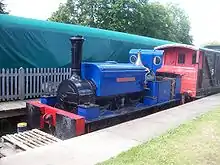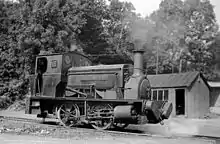Manning Wardle
Manning Wardle was a steam locomotive manufacturer based in Hunslet, Leeds, West Yorkshire, England.

Precursor companies
The city of Leeds was one of the earliest centres of locomotive building; Matthew Murray built the first commercially successful steam locomotive, Salamanca, in Holbeck, Leeds, in 1812. By 1856, a number of manufacturers had sprung up in the city, including Kitson and Company, the Railway Foundry, and E. B. Wilson and Company.
Manning Wardle

E.B.Wilson and Company operated in Leeds from 1838 to 1858. The company’s designs were purchased by Manning Wardle & Company, who located their Boyne Engine Works (established in 1840) in Jack Lane in the Hunslet district of the city. Within the next few years, two other companies, the Hunslet Engine Company and Hudswell, Clarke & Company also opened premises in Jack Lane. There was a good deal of staff movement between the three firms, leading to similar designs leaving all three works. Whilst Hudswell Clarke and Hunslet Engine Company built a wide variety of locomotive types, Manning Wardle concentrated on specialised locomotives for contractor’s use, building up a range of locomotives suitable for all types of contracting work.
Many Manning Wardle locomotives – of standard gauge and various narrow gauges – were exported to Europe, Africa, the Middle East (e.g. the Palestine Railways Class M), the Indian sub-continent, Australasia (e.g. NZR Wh class) and South America.
Decline and closure
The company employed traditional construction throughout its existence, and failed to take advantage of the more efficient mass production techniques becoming available. As a result, Manning Wardle became more uncompetitive. The company ceased trading in 1927, after producing more than 2,000 steam locomotives.
The last complete locomotive was No. 2047, a standard gauge 0-6-0ST delivered to Rugby Cement Works in August 1926. This locomotive was initially preserved at the Kidderminster Railway Museum on static display, but has now been moved to the Severn Valley Railway's workshop Bridgnorth to be dismantled and assessed for a return to working order. It will need a new boiler at least. Dismantling started in September 2011 and the old boiler is now in the SVR Boiler Shop so design work on a new boiler can begin.
Acquisition
Following closure in 1926, the company's drawings, designs, equipment and customers were acquired by Kitsons who made twenty three locos of Manning Wardle designs until they also closed in 1938. The patterns were passed to Robert Stephenson and Hawthorne who built a further five locos of Manning Wardle design. Today the Manning Wardle designs are owned by the Hunslet-Barclay, who are still a provider of services to the rail industry, based in Kilmarnock, Scotland. The intellectual property rights for historic locomotive designs are held by the Hunslet Engine Company.
The trademark name Manning Wardle is owned by a company formed in 1999 to preserve the name for the Lynton & Barnstaple Railway, which from 1898 to 1935 operated what have become some of the company's most famous products, narrow gauge 2-6-2T engines: Exe, Taw, Yeo and later Lew.
Preservation
Many locomotives of the company have been preserved, as listed below
Steam
- No. 576 of 1875: Norsk Hoved-Jernbane No. 25 (NHJ Class D/NSB Class 7), on display at the Norwegian Railway Museum in Hamar, Norway.[2]
- No. 815 of 1881: Preserved and on static display at the Railway Museum, Saitama city, Saitama Pref. Japan.
- No. 865 of 1882: Aldwyth - Preserved and on static display at the Leeds Industrial Museum, in Armley, West Yorkshire, Northern England.
- No. 641 of 1877: Sharpthorn - Preserved and on display at the Bluebell Railway, in South East England.
- No. 1207 of 1890: The Welshman
- No. 1210 of 1891: Logan and Hemingway No. 30 Sir Berkeley - Preserved and undergoing overhaul on the Middleton Railway, in West Yorkshire, Northern England.
- No. 1248 of 1892: Norsk Hoved-Jernbane No. 11 (NHJ Class D/NSB Class 7), running at the Krøderen Line in Buskerud, Norway.[3]
- No. 1317 of 1895: Birmingham Corporation Rhiwnant
- No. 1382 of 1897: Cilgwin Slate Co. Ltd, Jubilee 1897
- No. 1532 of 1901: Midland Coal, Iron and Coke Co. Newcastle - Preserved and currently stored at the Beamish Museum, in North East England
- No. 1601 of 1903: John Aird & Co. No. 138 Matthew Murray - Preserved and running on the Middleton Railway, in West Yorkshire, Northern England.
- No. 1762 of 1910: Lloyds Ironstone Co. Ltd. No. 14 Dolobran - Preserved and undergoing restoration on the Great Central Railway (Nottingham).
- No. 1781 of 1911: New South Wales Government Public Works Department
- No. 1795 of 1912: T. W. Ward Ltd. E.B.Wilson - Preserved and currently awaiting restoration at Barrow Hill, in Derbyshire.
- No. 1802 of 1912: Possum
- No. 1877 of 1915: Chattenden and Upnor Railway Chevallier
- No. 1896 of 1916: New South Wales Government Railway No. 1021 Cardiff
- No. 1955 of 1917: Park Gate Iron and Steel Company No. 14 Charwelton - Preserved and undergoing overhaul on the Kent & East Sussex Railway, in South East England.
- No. 2009 of 1921: Lloyds Ironstone Co. Ltd. No. 41 Rhyl - Preserved and undergoing restoration on the Great Central Railway (Nottingham).
- No. 2010 of 1921: Lloyds Ironstone Co. Ltd. No. 42 Rhondda
- No. 2015 of 1921: Cardiff Corporation Waterworks No. 5 Abernant - Preserved and awaiting restoration on the Great Central Railway (Nottingham).
- No. 2018 of 1922: Littleton Colliery Littleton No. 5 - Preserved and currently out of use, at the Avon Valley Railway, in Gloucestershire.
- No. 2025 of 1923: Cadbury Bros. No. 7 Winston Churchill
- No. 2047 of 1926: Rugby Portland Cement No. 4 Warwickshire It was the last locomotive built by Manning Wardle and is preserved and undergoing overhaul on the Severn Valley Railway.
Diesel and electric
- TBA
References
- Bluebell Railway. "Manning Wardle 0-6-0ST 4 "Sharpthorn", built in 1877". BRPS. Retrieved 7 April 2014.
- "7a 25". Norsk jernbanemuseum.
- "7a 11". Krøderbanen -7a 11.
External links
| Wikimedia Commons has media related to Manning, Wardle and Company. |